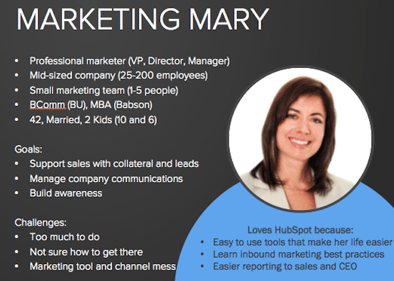How To Create Buyer Personas with Real Data

Marketing without targeting your buyer persona is kind of like throwing mud at the wall. You throw it hard enough, and some of it will stick. However, the problem with marketing without keeping your personas in mind is that it generally leads to poor conversion rates. Maybe every so often one is successful, but you're also dealing with a lot of misses.
Creating buyer personas will transform your sales process. You're no longer taking a shot in the dark, now you can tailor your message to your targeted audience during each stage of the buyer’s journey with real-life data.
What are buyer personas?
Buyer Personas are detailed representations of the different segments of your target audience. Backed by real
data, the fictional generalizations formulate the “who” behind the buying decisions of your products or services. They help you market to your customer from the words you use to the manner you “sell” them. In fact, buyer personas are critical in every single stage of the process including; content creation, product development and sales follow-up. Anything that relates to customer acquisition and retention can be linked back to buyer personas and they make it easier for you to cater to your ideal customer’s needs, behaviors and concerns.
 "Marketing Mary" Buyer Persona - Courtesy of Hubspot.com
"Marketing Mary" Buyer Persona - Courtesy of Hubspot.com
What are “Negative” personas?
While buyer personas generalize your ideal customer, negative personas represent whom you don’t want as a customer. This could be someone who can’t afford your service or product, or possibly a student who is only engaging with your content for research. Anyone who is unqualified should fall into this bucket…don’t be wasting your time or resources to convert them.
How to create buyer personas
The task of creating buyer personas may seem daunting, but the truth is, they really aren’t that hard. You need to ask the right questions to the right people, and aggregate the information in a simple and helpful way to the people in your business. Every single person from your company, whether they’re in sales, marketing, or advertising, should know your personas like the back of their hand.
The strongest buyer personas are not just based upon market research via your sales team, they also include insights gathered from your actual customer base through surveys and interviews. Depending on your customer’s wants and needs you could have as little as one persona or as many as five.
Tip: If you’re new to buyer personas, start small! Fully flush out one or two personas, you can always add more down the line if needed.
Methods to Gather the Information You Need
- Interview your sales team about the leads they’re interacting with the most. Can they make generalizations about the types of customers they’re bringing to your business?
- Use form fields that capture your most important persona information. Is it important what size the lead’s company is? Does it make a difference if they’re a manager or a junior-level employee? You can also use it to segment which product or service the user is interested in.
- Survey your customer base. This might be the most valuable of them all. What better way to learn about your ideal customer than straight from their mouths?
- Use Facebook Insights to examine your existing Facebook audience (if Facebook is a viable channel for your business). You can also use the tool to examine and gain insights on your email list.
- Use Google Analytics to learn the age, gender, and how many sessions it took for the user to convert.
What Questions to Ask
When interviewing the sales team or customer base you want to ask enough questions so you can learn how your customer’s tick. There should be a mix of professional and lifestyle questions so you can truly understand how your customer’s mind works.
Some questions you should ask are:
- What makes customers buy from you the first time?
- What keeps them coming back?
- What results do your customers expect to achieve as a result of purchasing your solution?
- What’s the basic demographic data?
- What is this person in charge of or expected to manage? What is their role?
- What are common influencers of their decision-making?
- What does a day in their life look like?
- Where do they go for information?
- What are their goals?
- What are their challenges?
How to Set Up the Interview
Customers
As mentioned above, this is probably the most valuable group of people you can hear from. They have already bought from you and engaged with your company so they know what they liked about the buying process, but they also know what they disliked too. You may even learn something your business can improve on to help make the buyer’s journey more enjoyable and keep them coming back.
Unlike your sales team, your customer base will need a little push to help you out. Consider offering an incentive. Incentives give people a reason to interact with you when they don’t necessarily have to. A simple gift card to Starbucks or a prepaid visa card should do the trick.
If you can’t gather a group of your customers for a focus group, or call them individually, the next best option is to send out a survey. Make the questions worthwhile. Typically, customers don’t want to spend a ton of time filling out a questionnaire, so, get down to the nitty gritty and try to capture the most significant information from them without annoying them with too many questions.
Tip: Survey tools like Typeform, SurveyMonkey and GoogleForms help you create and analyze your data for free.
How to Compile Your Data
After you’ve gone through your surveys and interviews, you’ll have a lot of raw data about your ideal (and maybe not so ideal) customer. The last step is to sift through your research and identify patterns, commonalities, and differentiators between your segmented groups. Develop at least one buyer persona completely. If you have one persona 100% flushed out but you still recognize some pain points or goals still aren’t being met, move on to the next one.
Tip: Give your persona a name (like Marketing Mary or Architect Andy), and include a photograph of what this person looks like.
Buyer Personas should have their own unique set of challenges, goals, and buying habits. Throughout this process you may learn you only have one persona, or you may discover that you have five. As long as each one is unique to them you are in good shape.
Once your buyer personas are organized and fully developed, share them with the rest of your company. Every single person in your organization can benefit from understanding how the person you're targeting works.

April 5, 2016